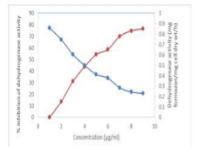Inhibition of dehydrogenase activity in S. typhimurium by ethanolic and methanolic extracts of Carica papaya and Ocimum gratissimum
Main Article Content
Abstract
Dehydrogenase and inhibitions of dehydrogenase activities in Salmonella typhimurium by ethanolic and methanolic leaf extracts of Ocimum gratissimum and Carica papaya were investigated. Dehydrogenase activity assay was carried out using 2, 3, 5-triphenyl tetrazolium chloride (TTC) as the electron acceptor. Pure culture of S. typhimurium was exposed to varied concentrations of ethanolic and methanolic extracts of Ocimum gratissimum and Carica papaya [0-4000 μg/ml]. The ethanolic and methanolic extracts exhibited a concentration dependent response against the tested organism. Results obtained revealed that the ethanolic extracts showed a higher bactericidal effect on the test organism than the methanolic extracts at the threshold and total inhibitory concentrations. The IC50 were 45.349 and 15.697; IC100 were 43.732 and 35.526 for ethanolic extracts of Carica papaya and Ocimum gratissimum respectively while the IC50 were 7.108 and 13.696; IC100 were 40.815 and 31.104 for methanolic extracts of Carica papaya and Ocimum gratissimum respectively. This in-vitro study further revealed that the leaf of Carica papaya was more potent on Salmonella typhimurium than the leaf of Ocimum gratissimum. The findings from this study seem to provide the in-vitro evidence that justifies Carica papaya and Ocimum
gratissimum as good candidate medicinal plants for the potential treatment of Salmonella typhimurium infections
Downloads
Article Details

This work is licensed under a Creative Commons Attribution-NonCommercial-NoDerivatives 4.0 International License.
References
Adebolu, T. T. and Oladimeji, S. A. (2005). Antimicrobial activity of leaf extracts of Ocimum gratissimum on selected diarrhea causing bacteria in
Southwestern Nigeria. African Journal of Biotechnology 4(7): 682-684.
Adeola, S.A., Folorunso, O.S., Okedeyi, O.O., Ogungbe, B.F., Babatimehin, O.B. and Thanni, O.Z. (2014). Antimicrobial activities of the volatile oil of Ocimum gratissimum and its inhibition on partially purified and characterized extracellular protease of Salmonella enteritidis. American journal of drug discovery and development. 4: 180-193.
Akujobi, C.O., Ogbulie, J.N and Njoku, H.O. (2010). The extract of Ocimum gratissimum on the dehydrogenase activities to clinical isolates of
Escherichia coli and Staphylococcus aureus. Journal of Agricultural Technology. 6 (1): 57-65.
Alisi, C.S., Nwanyanwu, C.E., Akujobi, C.O. and Ibegbulem, C.O. (2008). Inhibition of dehydrogenase activity in pathogenic bacteria isolates by aqueous extracts Musa paradisiaca (Var Sapientum). African Journal of Biotechnology 7(12): 1821-1825.
Anyanwu,N.I. and Semple, T.K. (2016). Assessment of the effects of phenanthrene and its nitrogen heterocyclic analogues on microbial
activity in soil. Springerplus 5: 279.
Chah, K.F., Okafor, S.C and Oboegbulem, S.I (2003): Antimicrobial resistance of nonclinical Escherichia coli strains from chicken in Nsukka, South-East Nigeria. Nigeria Journal of Animal Production, 30(1): 101-106.
Cheesebrough, M., District laboratory practice in tropical countries, part 2, Cambridge University Press, Cambridge, UK, 2006, pp. 137-150.
Douglass, F. (2002). The Genus Salmonella. American Journal of Medical Science 13 (1): 23-29.
De Knegt, L.V., Pires, S.M., Hald, T. (2015). Attributing foodborne salmonellosis in humans to animal reservoirs in the European Union using a multi-country stochastic model. Epidemiology of Infections 143: 1175-1186.
Ezekwesili, C.N., Obiora, K.A. and Ugwu, O.P. (2004). Evaluation of anti-diarrheal property of crude aqueous extracts of Ocimum gratissimum in rats. Biokemistri 16(2): 122-131. Gopi, C., Natraja Sekha, Y. And Ponmurugan, P. (2006). In vitro multiplication of Ocimum gratissimum through direct regeneration. African Journal of Biotechnology. 5(9): 723-726.
Holetz, F.B., Nakamura, T.U, Filho, B.P.D., Cortez, D.A.G., Diaz, J.A.M. and Nakamura, C.V. (2003). Effect of essential oil of Ocimum gratissimum on
Herpetomonas samuelpessoai. Journal of Biotechnology. 42: 269-276.
Justina, Y.T. and Solomon, A.M. (2017). Proximate, phytochemical and in vitro antimicrobial properties of dried Leaves from Ocimum gratissimum. Journal of Preventive Nutrition and Food Science. 22(3): 191-194.
Lemos, J.A., Passos, X.S., Fernandes, O.F.L., Paula, J.R., Souza, L.K.H., Lemos, A.A. and Silva, M.R.R (2005). Antifungal activity of essential oil from Ocimum gratissimum towards Cryptococcus neoformans. Journal of Biotechnology. 100(1): 55-58.
Martelli, F. and Davies, R.H. (2012). Review host adapted serotypes of Salmonella enterica. Salmonella serovars isolated from table eggs: An overview. Journal of Applied Environmental Microbiology. 45: 45-48.
Nwachukwu, O.I. and Pulford, I.D. (2011). Microbial respiration as an indication of metal toxicity in contaminated organic materials and soil. Journal of Hazardous Materials. 185(2-3): 1140-7.
Nwaogu, L.A., Alisi, C.S., Igwe, C.U. and Ujowundu, C.O. (2007). Phytochemical and antimicrobial activity of ethanolic extract of Landolphia owariensis leaf. African Journal of Biotechnology 6(7): 890-893.
Nwaogu, L.A., Alisi, C.S., Igwe, C.U. and Ujowundu, C.O. (2008). A comparative study of the antimicrobial properties of ethanolic extracts of Landolphia owariensis leaf and root. African Journal of Biotechnology 7(4): 368-37217.
Nweke, C.O., Okolo, J.C., Nwanyanwu, C.E. and Alisi, C.S. (2006). Response of planktonic bacteria of New Calabar River to zinc stress. African Journal of Biotechnology 5(8): 653-658.
Nweke, C.O., Okolo, J.C., Nwanyanwu, C.E. (2007). Toxicity of zinc to heterotrophic bacteria from tropical river sediment. Journal of Applied Ecological and Environmental Research. 5(1): 123-132.
Nwuche, C. and Ugochi, E. (2008). Effects of heavy metal pollution on the soil microbial activity. International journal of Environmental Science and Technology. 5(3): 116-119.
Sinha, S., Pazhani, P.G., Sen, B., Niyogi, K.S. (2006). Molecular characterization of Salmonella enterica serotype Worthington isolated from childhood diarrhea in Kolkata. Journal of Infectious Diseases. 59: 275-6


